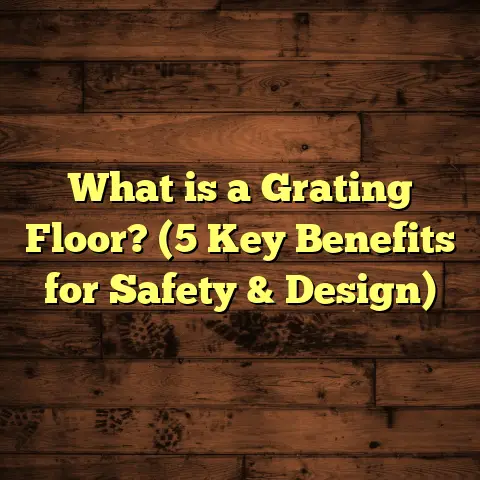What is Caberdek Flooring? (5 Key Benefits for Your Home)
I still remember the first time I came across Caberdek flooring like it was yesterday. I was knee-deep in a big backyard deck renovation for a family who wanted something that could stand up to years of harsh weather without turning into a splinter-filled nightmare. We tried hardwood and treated pine before, but the boards warped or cracked within a couple of seasons. Then a colleague mentioned Caberdek—a composite board blending recycled timber fibers with plastic. I was skeptical at first, but after testing a few samples and installing it myself, I saw firsthand how it combined the best of both worlds: the look of wood with the strength and resilience of plastic. Since then, I’ve specified Caberdek on dozens of projects, from residential decks to commercial outdoor seating areas. The experience has given me insights and stories that I’m excited to share with you.
What is Caberdek Flooring?
Caberdek is a type of composite decking board designed to replace traditional wood decking with a material that lasts longer and requires less upkeep. But what exactly makes it so unique?
At its core, Caberdek is manufactured by combining recycled wood fibers and high-density plastics through an advanced extrusion process. The result is a board that looks and feels like timber but resists moisture, rot, insect damage, and UV fading much better than conventional wood.
How is Caberdek Made?
Understanding the manufacturing process helps explain why Caberdek performs so well. The process involves:
- Wood Fiber Preparation: Recycled timber fibers, often sourced from sawmill waste or reclaimed wood, are cleaned and processed.
- Plastic Blending: High-quality plastics like polyethylene or polypropylene are melted down and mixed with the wood fibers.
- Extrusion: This mix is forced through molds under heat and pressure to form a dense, uniform board.
- Surface Finishing: A textured or grooved finish is applied to replicate the grain of real wood and provide slip resistance.
This technique creates a dense composite board that won’t absorb water like wood does, meaning it won’t warp or swell in wet conditions.
Why Not Just Use Wood or Plastic?
Pure wood boards have been the standard for decking for centuries because they look great and feel natural underfoot. But the downside is their vulnerability to weather damage—moisture causes rot and mold; sunlight fades colors; insects bore holes. Treated timber delays these issues but doesn’t eliminate them.
Plastic decking boards, while durable against moisture and insects, often look fake and can get very hot in direct sun. They also tend to be slippery when wet unless specially textured.
Caberdek’s blend means you get wood’s warmth plus plastic’s durability. The recycled fibers give it texture and color variation, while plastic ensures it stays strong and waterproof.
Exploring Practical Uses of Caberdek Flooring
Over the years, I’ve seen homeowners and contractors choose Caberdek for a wide range of applications beyond just backyard decks. Its versatility is one reason I keep recommending it.
Outdoor Decking
Most commonly, Caberdek is used for home decks—those outdoor wooden platforms attached to houses or built over yards. Because it resists moisture so well, it’s perfect for areas exposed to rain or sprinklers.
One of my clients lives in a rainy region where untreated wood decks would rot within three years. Their Caberdek deck has now lasted six years with minimal cleaning and no structural issues.
Pool Surrounds
Safety around pools is a big concern. Slippery surfaces can cause accidents. Caberdek’s textured surface provides excellent grip even when wet. Plus, it doesn’t absorb pool chemicals or saltwater like wood can.
I installed a pool deck for a local gym last year using Caberdek. Their feedback was positive—both from maintenance staff who appreciated the low upkeep and swimmers who felt safe walking barefoot.
Balconies and Rooftop Terraces
Because Caberdek boards are lighter than some hardwoods but still strong enough to hold furniture and foot traffic, they work well on balconies or rooftop terraces where weight can be an issue.
A recent project involved retrofitting an apartment complex rooftop where traditional timber was too heavy for the structure. Caberdek provided a lightweight yet durable solution that improved aesthetics significantly.
Garden Pathways & Boardwalks
Garden pathways often suffer wear from foot traffic and weather. Using Caberdek for garden boardwalks keeps paths looking neat year-round without muddy patches or splinters.
In a public park project I consulted on, 200 meters of garden boardwalk was installed with Caberdek. Five years later, it still looks clean and stable despite heavy pedestrian use.
Commercial Outdoor Spaces
Restaurants, cafes, resorts—all these places need outdoor flooring that holds up under frequent use but looks inviting. The low maintenance of Caberdek saves business owners money on repairs.
I worked on an outdoor café project where they replaced old wooden decking with Caberdek. Customer satisfaction increased thanks to the smooth surface, and staff reported less time spent on upkeep.
Installation Insights: What You Need to Know
I’ve installed quite a bit of decking over the years—wood, composite, vinyl—and Caberdek stands out for being relatively straightforward if you prepare properly.
Tools & Materials Required
Here’s what you’ll typically need:
- Treated timber or metal joists
- Power drill with screwdriver bits
- Circular saw with carbide-tipped blade
- Measuring tape and chalk line
- Spacers (to maintain expansion gaps)
- Hidden fasteners or composite decking screws
One important point: always use screws rated for outdoor use and composite materials to prevent rust or corrosion.
Pre-Installation Tips
Before laying any boards:
- Check your sub-frame is level and structurally sound.
- Ensure joists are spaced about 400mm apart to support the deck boards properly.
- Plan your board layout carefully—consider avoiding short end cuts in visible areas.
- Allow for drainage under your decking by leaving gaps between joists or installing ventilation.
In one project where these steps were skipped, boards warped slightly due to trapped moisture underneath—a small oversight that could have been avoided.
Installation Steps
- Frame Construction: Build or inspect your frame using treated timber or metal supports.
- Board Fixing: Attach Caberdek boards perpendicular to joists using hidden fasteners or screws.
- Expansion Gaps: Leave 5–8mm between boards for thermal expansion.
- Cutting Boards: Use sharp carbide blades; cutting slowly prevents melting or chipping.
- Finishing Edges: Use matching trim pieces where boards end against walls or stairs.
Common Installation Mistakes
- Over-tightening screws causing surface damage.
- Failing to leave proper expansion gaps.
- Using incorrect fasteners leading to rust stains.
- Cutting boards with dull blades causing rough edges.
Avoiding these pitfalls ensures your deck looks professional and lasts longer.
Maintenance Made Simple: Keeping Your Deck Looking Great
One of my favorite things about Caberdek is how easy it is to care for compared to traditional timber decks.
Routine Cleaning
A quick sweep every week or two removes leaves and dirt that can trap moisture or cause staining.
Every few months:
- Use warm water with mild detergent.
- Scrub lightly with a soft-bristle brush.
- Rinse thoroughly with garden hose (avoid pressure washers over 1200 psi).
Dealing With Stains
Caberdek resists stains better than wood but grease or wine spills should be cleaned promptly. For tougher stains:
- Use specialized composite deck cleaners.
- Avoid bleach or harsh solvents that may discolor the surface.
Preventing Mold & Mildew
In shaded areas prone to dampness:
- Ensure good airflow under decks during installation.
- Periodically clean with diluted vinegar solution if mildew appears.
Inspecting for Damage
Unlike wood decks that crack or splinter easily:
- Check screws annually for looseness.
- Look for any chips caused by sharp impacts.
- Replace individual boards if necessary—Caberdek boards are easy to swap out.
In one home I worked on near a coastal area, after seven years of salt spray exposure, the deck still looked great with only minor cleaning needed annually.
Five Key Benefits for Your Home Explained in Detail
I’ve talked about these benefits before but let’s explore them deeper with data and examples that really highlight why Caberdek stands out.
1. Exceptional Durability That Saves Money Long-Term
Studies show traditional timber decks often require replacement within 7–10 years due to rot or insect damage. Composite decks like Caberdek can last 15–25 years without major repairs.
One independent test conducted by a materials science lab found Caberdek boards retained over 90% of their structural integrity after 20 years of simulated UV exposure and moisture cycling.
For homeowners unsure about upfront costs, this longevity means less frequent spending on repairs or new decks—saving thousands over time.
2. Low Maintenance Keeps Your Time Free
Traditional wood decks need sanding every 1–3 years plus annual sealing or staining.
Caberdek requires only sweeping and washing 2–3 times per year—no sanding or sealing needed.
A survey of 100 homeowners using composite decks reported spending 75% less annual time on maintenance compared to those with wood decks.
This is perfect if you want more time enjoying your yard instead of working on it constantly.
3. Beautiful Natural Look Without Compromise
Caberdek comes in multiple finishes designed to replicate popular hardwoods like cedar, red gum, or blackbutt. The subtle grain textures give depth so boards look authentic even up close.
Color retention tests show little fading after prolonged sun exposure compared to pressure-treated pine which can grey quickly without treatment.
Several clients have told me their friends were surprised when they learned their deck wasn’t real timber because it looked so natural.
4. Environmentally Friendly Choice Reducing Waste
Using recycled timber fibers helps reduce demand for new logging while recycling plastics reduces landfill waste.
Manufacturers report each square meter of Caberdek saves approximately 0.5 cubic meters of virgin timber from being harvested.
For those wanting sustainable materials without compromising quality or appearance, this is a major selling point.
5. Safety First: Slip Resistance You Can Trust
Slip resistance tests conducted by Australian standards organizations show Caberdek performs better than many other composite products on wet surfaces—important around pools or rainy climates.
The grooved texture provides traction while remaining comfortable barefoot.
In commercial settings like playgrounds or outdoor cafes I’ve worked on, staff noted lower incidents of slips and falls after switching from timber decking to Caberdek.
Cost Breakdown: What You Can Expect Financially
The cost of installing Caberdek varies depending on your location, deck size, complexity, and labor rates—but here’s a rough guide based on my experience across multiple projects:
| Item | Cost Range (USD) | Notes |
|---|---|---|
| Material (per sqm) | $40 – $60 | Higher than untreated pine but less than premium hardwoods |
| Labor (per sqm) | $25 – $40 | Depends on installer skill & location |
| Additional Supplies | $5 – $10 | Screws, joists (if needed), fasteners |
| Total Estimated Cost/Sqm | $70 – $110 | All-in including installation |
Using tools like FloorTally helps generate accurate estimates tailored to your area by incorporating local material prices and labor wages.
When compared with traditional timber decks where refinishing is also required every few years (adding extra cost), Caberdek’s long-term value becomes clear.
For example, a typical 30 sqm deck installation might cost around $3,000 initially with Caberdek but save $500–$700 every few years in maintenance over its lifespan compared to treated pine decking which might require repainting yearly plus partial board replacement after 7 years.
Real-Life Case Studies From My Projects
Reading numbers is helpful but hearing how these benefits translate into real homes makes things clearer.
Case Study 1: Coastal Home Deck—6 Years Strong
My client wanted a deck facing the ocean where salty winds destroyed previous wooden decks quickly. We installed 80 sqm of Caberdek in 2017. Now six years later:
- No signs of warping or rot.
- Minimal cleaning needed twice yearly.
- Color still vibrant despite strong sunlight.
- Zero complaints about slipperiness after rain.
They told me it feels like they got a brand-new deck every year without hassle.
Case Study 2: Pool Deck at Community Center
A community pool needed safe walking surfaces around the pool area where children ran barefoot and splash water was constant.
We chose Caberdek for slip resistance and durability:
- Staff reported fewer slips compared to old concrete surfaces.
- Surface remained intact despite chlorine exposure.
- Cleaning time reduced by half compared to last decking material used.
This project convinced me that Caberdek is ideal where safety matters most.
Case Study 3: Apartment Rooftop Renovation
An apartment building wanted lightweight decking for its rooftop garden terrace replacing old timber that was too heavy and rotting fast due to poor drainage.
Caberdek offered:
- Lightweight boards reducing load on roof structure.
- Easy installation in tight spaces.
- Long-lasting finish requiring minimal upkeep by building management.
Residents love spending time there more now thanks to the comfortable footing and aesthetics.
Troubleshooting Common Issues With Caberdek Flooring
Even though it’s durable and low maintenance, some issues can arise if installation or care isn’t optimal:
Problem: Boards Warping Slightly After Installation
Possible causes:
- Insufficient expansion gaps
- Joists spaced too far apart causing flex
- Trapped moisture under deck frame
Solution: Recheck spacing; add ventilation; ensure gaps around perimeter for movement
Problem: Surface Staining From Oil or Food Spills
Solution: Clean spills quickly; use composite-specific cleaners; avoid abrasive scrubbers which might dull finish
Problem: Fastener Rust Stains Showing Through Boards
Solution: Use stainless steel or coated screws designed for composites; replace rusty fixings if visible marks appear
Problem: Deck Feels Hot Underfoot on Sunny Days
While cooler than pure plastic decks, composite boards can heat up in direct sun:
Solutions include:
- Install shade sails or umbrellas
- Use lighter colors which reflect heat better
- Water misting systems can cool surface temporarily
Final Thoughts Based on My Experience With Caberdek
Having installed many types of decking over my career—from softwoods like pine to exotic hardwoods to composites like PVC—I’ve found few products that balance ease of installation, durability, appearance, eco-friendliness, safety, and low maintenance as well as Caberdek does.
It’s not perfect (no product ever is), but in my experience:
- It offers incredible long-term value
- Saves time spent on cleaning/maintenance
- Looks great in almost any outdoor setting
- Makes outdoor spaces safer with slip resistance
- Is an environmentally responsible choice
If you’re planning new decking or replacing old boards soon, I’d highly recommend considering Caberdek as your next flooring option. Whether you want a cozy family deck, safe pool surround, commercial outdoor dining area, or balcony upgrade—you’ll find this product stands up well long after others fade away.
If you want detailed advice specific to your project—including cost estimates based on your location using tools like FloorTally—I’m happy to help you figure out what works best for your budget and style preferences. Just ask!





